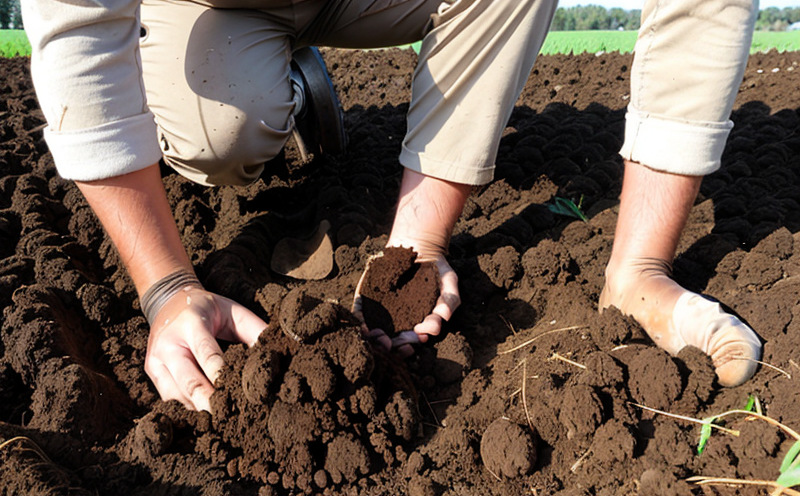Soil Aggregate Stability Testing
The integrity of soil aggregates is a critical factor in determining the fertility and productivity of agricultural land. Soil aggregate stability refers to the resistance of soil aggregates to fragmentation, which is essential for maintaining soil structure and ensuring that plants have access to necessary nutrients through an intact root zone. This service focuses on evaluating the strength and resilience of these aggregates using standardized testing methods.
Soil aggregates are clusters of small mineral particles held together by organic matter such as plant roots and microorganisms. These aggregates play a vital role in soil health by providing pathways for air, water, and nutrients to reach plant roots efficiently. When aggregates break down too quickly, it can lead to erosion, reduced nutrient availability, and diminished crop yields.
Standardized testing methods like the ISO 17892-1 provide a reliable way to measure soil aggregate stability. This test assesses how much weight can be placed on a soil sample before it crumbles, indicating its structural integrity. By conducting this test, we help clients understand the inherent stability of their soils and identify potential areas for improvement.
The process involves collecting representative soil samples from various depths in fields or plots under study. These samples are then air-dried, sieved to remove large particles, and dried again at a specific temperature. The next step is to gently crush the soil into small aggregates using a mechanical device designed specifically for this purpose. Once prepared, these aggregates are placed on a balance where they will be subjected to gradually increasing weights until they crumble.
The results from this test provide valuable insights into the physical properties of the soil and its potential for sustainable agricultural practices. For instance, low aggregate stability may indicate poor drainage or excessive tillage which could necessitate changes in farming techniques such as reduced tillage or cover cropping to enhance natural aggregation processes.
Our experienced team ensures that all tests are conducted according to internationally recognized standards ensuring accuracy and reliability of results. The findings from this testing can guide decision-making related to soil management strategies including liming, fertilization programs aimed at improving organic matter content in soils, and conservation tillage practices."
Industry Applications
The application of soil aggregate stability tests extends beyond just agricultural fields; it also plays a crucial role in forestry and landscape management. Healthy soil aggregates are necessary for seedling establishment and growth rates within plantations. In horticulture, maintaining optimal soil structure helps in achieving better root development leading to healthier plants.
For researchers studying the effects of climate change on soils, these tests offer insight into changes over time due to increased CO2 levels or altered rainfall patterns affecting microbial activity involved in aggregate formation. Similarly, when developing new crop varieties resistant to drought stress conditions, understanding soil aggregation behavior provides crucial information about root zone health and water availability.
In environmental monitoring projects focused on reclamation sites after mining activities or urban developments, assessing pre- versus post-construction aggregate stability allows us to evaluate the effectiveness of reclamation efforts. This data is vital for determining whether additional measures need to be taken to restore natural soil functions."
International Acceptance and Recognition
The international community widely accepts ISO 17892-1 as a standard methodology for measuring soil aggregate stability across different countries and regions. Many regulatory bodies require compliance with these standards when evaluating the environmental impact of agricultural operations or land management practices.
Agricultural organizations like FAO (Food and Agriculture Organization) recommend using this test to promote sustainable farming methods worldwide. Forestry associations also incorporate similar principles into their guidelines for forest regeneration projects aimed at restoring degraded ecosystems."
Use Cases and Application Examples
Case Study 1: A large-scale farm in North America wanted to improve its yields by addressing issues related to poor soil structure. They chose our laboratory for conducting comprehensive soil quality assessments, including aggregate stability tests. After analyzing the results, they implemented improved irrigation practices along with organic amendments rich in carbon content which helped enhance natural aggregation processes within their soils."
Case Study 2: A European company involved in reforestation initiatives faced challenges ensuring that newly planted saplings established properly on reclaimed land. By incorporating soil aggregate stability tests into their project planning process, they were able to identify areas requiring additional treatment before planting took place, thereby increasing overall success rates."
Case Study 3: A research institute studying the effects of rising CO2 levels on tropical soils utilized our laboratory services for regular monitoring of aggregate stability over several years. Their findings contributed significantly towards understanding long-term impacts and informing policy recommendations aimed at mitigating negative consequences."
These case studies exemplify how soil aggregate stability testing serves as an essential tool in various sectors, contributing to improved agricultural practices, sustainable forestry management, and effective land reclamation efforts globally."





